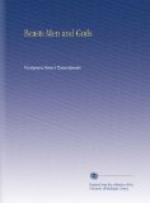Suddenly, three shots sounded. They were hardly more than the report of a Flobert rifle; but they were genuine shots, because the officer and two soldiers fell to the ground. The other soldiers grabbed their rifles and, with fear, looked about for the enemy. Four more were soon unseated and suddenly I noticed our rearguard brute raise his rifle and aim right at me. However, my Mauser outstrode his rifle and I was allowed to continue my story.
“Begin!” I cried to my friend and we took part in the shooting. Soon the meadow began to swarm with Soyots, stripping the fallen, dividing the spoils and recapturing their horses. In some forms of warfare it is never safe to leave any of the enemy to renew hostilities later with overwhelming forces.
After an hour of very difficult road we began to ascend the mountain and soon arrived on a high plateau covered with trees.
“After all, Soyots are not a too peaceful people,” I remarked, approaching the Governor.
He looked at me very sharply and replied:
“It was not Soyots who did the killing.”
He was right. It was the Abakan Tartars in Soyot clothes who killed the Bolsheviki. These Tartars were running their herds of cattle and horses down out of Russia through Urianhai to Mongolia. They had as their guide and negotiator a Kalmuck Lamaite. The following morning we were approaching a small settlement of Russian colonists and noticed some horsemen looking out from the woods. One of our young and brave Tartars galloped off at full speed toward these men in the wood but soon wheeled and returned with a reassuring smile.
“All right,” he exclaimed, laughing, “keep right on.”
We continued our travel on a good broad road along a high wooden fence surrounding a meadow filled with a fine herd of wapiti or izubr, which the Russian colonists breed for the horns that are so valuable in the velvet for sale to Tibetan and Chinese medicine dealers. These horns, when boiled and dried, are called panti and are sold to the Chinese at very high prices.
We were received with great fear by the settlers.
“Thank God!” exclaimed the hostess, “we thought . . .” and she broke off, looking at her husband.
CHAPTER X
THE BATTLE ON THE SEYBI




